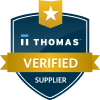We Offer Low Minimum Quantities and Fast Delivery of Tohsiba, Kyocera, Ceramtec, Coorstek, Corning and Dynasil Ceramic Substrates

Accumet is an experienced and respected microelectronic materials supplier and proud to be a reseller and processing center for Toshiba®, Kyocera®, Ceramtec®, CoorsTek®, Corning®, and Dynasil® ceramic substrates and other materials. We offer stocking plans and processing services to meet your production schedules, and can deliver quick prototypes and samples to your desired thicknesses, surface finishes, shapes and patterns. With Accumet, you get the exact same high quality substrates from name brand suppliers, plus we can lap, polish, cut, drill, and mark them any way you need. We’ll process and ship orders as small 10 pieces.
We routinely stock, and offer value-added processing of these common substrate materials:
- Alumina 96%
- Alumina 99.5%
- Alumina 99.6%
- Beryllium Oxide, BeO
- Aluminum Nitride, AlN
- Fused Silica
- Fused Quartz/Silicon Dioxide (SiO2)
- Sapphire
- Tungsten Carbide
- Garrolite
Other materials in stock include adhesives and tapes for medical devices, frozen epoxy preforms, RF/microwave absorbers, EMI absorbing rubber gaskets, metals, foils, Teflon, Kevlar, and various plastics and fabrics.
Application Note: The reason alumina (Al) +99% is a common choice for microelectronics, is that it offers a superior surface for fabricating thin film circuitry. When high heat conductivity is required, designers often choose beryllium oxide (BeO). (BeO is costlier and is falling out of favor due to being less friendly to the environment, but it is still employed routinely. Accumet remains one of a few suppliers who stock and process it). Alternatively, aluminum nitride (AlN)—which offers slightly less heat conductivity than BeO—is much easier to gain approval of. Plus, it’s simple to handle, and provides medium-grade performance attributes that meet the requirements of many applications.
In addition to your main substrate material, we recommend you take into consideration your surface or embedded material choices as well. These materials can complicate fabrication and add unplanned processing time and expense. Surface metals, for example, tend to reflect laser energy and can possibly cause slight changes in a laser’s kerf, if/when you laser process your completed circuits. The laser can also cause the metals on the backside of the substrate to melt, meld and bead. Glass also tends to chip when laser cut, especially on the exit side of the laser beam. And polymers may melt when the laser beam gets within 0.005" of them.
To learn more, download our tech brief, "Selecting the Right Substrate Materials for High Power Electronics."
Contact us today to set up your substrate materials stocking and processing plan.




